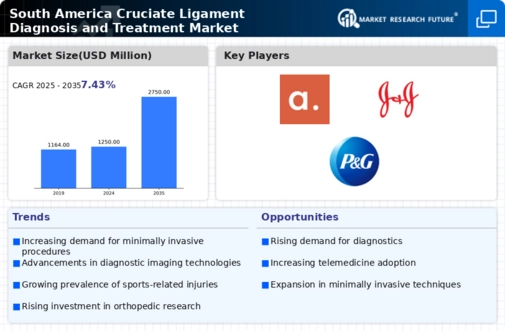Market Growth Projections
The Global South America Cruciate Ligament Diagnosis and Treatment Market Industry is on a trajectory of significant growth, with projections indicating a rise from 1250 USD Million in 2024 to 2750 USD Million by 2035. This growth reflects a compound annual growth rate (CAGR) of 7.43% from 2025 to 2035, driven by various factors including technological advancements, increased awareness of orthopedic health, and government support. The market's expansion is indicative of the evolving healthcare landscape in South America, where the demand for effective diagnosis and treatment options continues to rise.
Rising Geriatric Population
The aging population in South America is contributing to a growing prevalence of degenerative knee conditions, including cruciate ligament injuries. As individuals age, the risk of sustaining such injuries increases, necessitating effective diagnostic and treatment options. The Global South America Cruciate Ligament Diagnosis and Treatment Market Industry is poised to expand as healthcare systems adapt to meet the needs of this demographic. With an increasing focus on geriatric care and rehabilitation, the market is likely to see sustained growth, driven by the demand for specialized orthopedic services tailored to older adults.
Advancements in Medical Technology
Technological advancements in diagnostic and surgical procedures are transforming the landscape of the Global South America Cruciate Ligament Diagnosis and Treatment Market Industry. Innovations such as arthroscopic surgery and improved imaging techniques enhance the accuracy of diagnoses and the effectiveness of treatments. These advancements not only reduce recovery times but also improve patient outcomes, making them appealing to both healthcare providers and patients. As the market evolves, the integration of artificial intelligence and robotics in surgical procedures may further streamline operations, potentially increasing market value significantly by 2035.
Government Initiatives and Funding
Government initiatives aimed at improving healthcare infrastructure in South America are likely to bolster the Global South America Cruciate Ligament Diagnosis and Treatment Market Industry. Increased funding for healthcare facilities and programs focused on sports medicine can enhance access to quality care for individuals suffering from cruciate ligament injuries. Such initiatives may include the establishment of specialized clinics and training programs for healthcare professionals. As these efforts gain momentum, the market is expected to benefit from improved service delivery and patient outcomes, potentially reaching 2750 USD Million by 2035.
Rising Incidence of Sports Injuries
The increasing participation in sports and physical activities across South America contributes to a higher incidence of cruciate ligament injuries. This trend is particularly evident among young athletes, leading to a growing demand for effective diagnosis and treatment options. The Global South America Cruciate Ligament Diagnosis and Treatment Market Industry is projected to reach 1250 USD Million in 2024, driven by the need for advanced surgical techniques and rehabilitation programs tailored for sports injuries. As awareness of injury prevention and management rises, healthcare providers are likely to invest in innovative solutions, further propelling market growth.
Growing Awareness of Orthopedic Health
There is a notable increase in public awareness regarding orthopedic health and the importance of timely intervention for cruciate ligament injuries. Educational campaigns and community programs in South America are fostering a better understanding of these injuries, leading to earlier diagnoses and more effective treatments. This heightened awareness is likely to drive the Global South America Cruciate Ligament Diagnosis and Treatment Market Industry, which is expected to grow at a CAGR of 7.43% from 2025 to 2035. As individuals become more proactive about their health, the demand for specialized orthopedic services is anticipated to rise.














Leave a Comment